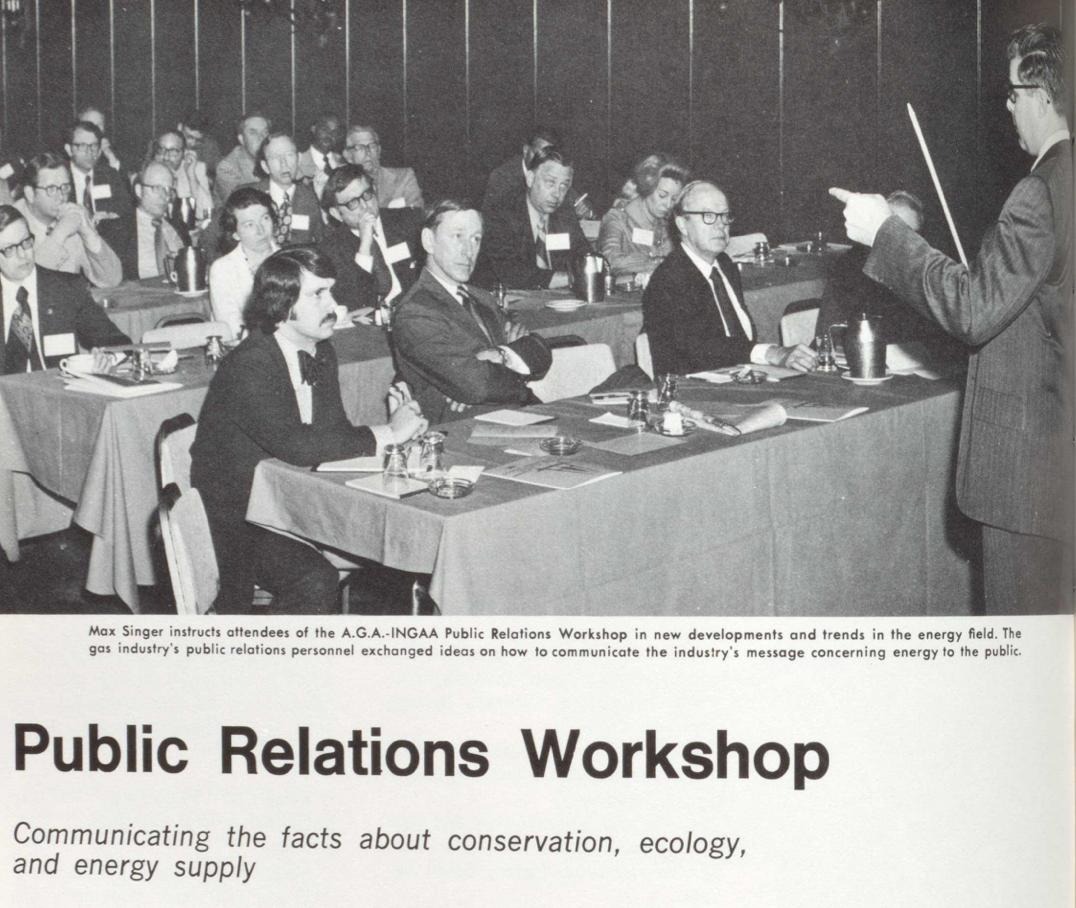In the 1970s, Dr. Bernard Goldstein, a young professor at the New York University School of Medicine, researched the health impacts of nitrogen dioxide (NO2) produced by gas stoves. In a series of studies, Goldstein and his colleagues identified a higher incidence of respiratory problems among schoolchildren from homes with gas stoves. Fifty years on, Goldstein, now emeritus professor of Environmental and Occupational Health at the University of Pittsburgh, recently told NPR “it’s way past time that we were doing something about gas stoves.”
Explanation for this 50-year delay can be found in the hundreds of pages of documents referenced in a new report by the Climate Investigations Center (CIC), covered by NPR. The report illustrates the gas industry’s multi-decade PR campaign dating back to the 1970s to manufacture controversy over the health effects of gas stove emissions and avoid regulation. This PR campaign relied on tactics used by Big Tobacco to promote doubt and uncertainty over the link between cigarettes and cancer.
The documents uncovered by CIC reveal that the gas industry funded its own scientific studies using the same laboratories, consultants, and statisticians as Big Tobacco; and that it was advised by the same public relations firm that masterminded the tobacco strategy — Hill & Knowlton — specifically by the Hill & Knowlton executives responsible for the tobacco account.
Led by its trade group the American Gas Association (AGA), and advised by Hill & Knowlton, the gas industry sponsored its own studies into the health effects of gas stove emissions, then amplified findings to promote doubt — without consistently disclosing its financial ties. While a growing body of independent science identified a higher prevalence of respiratory problems in gas-stove homes, the AGA-funded studies found “no association” between gas stove emissions and respiratory illness. The industry used these studies to influence public opinion, undermine public health efforts, and block regulation.
The gas industry also paid third-party consultants and statisticians to attack independent science and maximize uncertainty. These consultants concluded that the overall evidence was “conflicting” or “inconclusive” and that “additional NO2 epidemiological data” were needed.
This shaped federal regulation of both indoor and outdoor air pollution. Gas industry studies influenced decisions taken by the Environmental Protection Agency (EPA) in the 1980s and 1990s not to revise outdoor NO2 standards. Likewise, in 1986 when the Consumer Product Safety Commission sought guidance about the development of potential measures limiting gas stove NO2 emissions, AGA-sponsored studies featured prominently in deliberations, leading to the conclusion that “the evidence was somewhat inconsistent” and further research was needed.
This gas industry influence campaign continues to the present day. In December 2022, when a peer-reviewed study estimated that “nearly 13 percent of childhood asthma cases in the United States can be linked to having a gas stove in the home,” AGA paid the consulting firm Gradient Corporation to criticize the data. Gradient has a long history of defending industry clients against public health research.
Responding to detailed questions from CIC, AGA’s President and CEO Karen Harbert acknowledged that the gas industry has “collaborated” with “experts” to “inform and educate regulators” about the safety of gas stoves. “Our focus is on the facts and independent analysis,” said Harbert. The documents, however, suggest otherwise.
We sat down with Rebecca John, the researcher and author of CIC’s report, to talk through the key documents that informed the investigation; all of the documents referred to in the report are publicly available on DocumentCloud. The following conversation has been edited for length and clarity.
Brendan DeMelle
Before we get into the documents, take us behind the scenes into your research. Was there a moment in which you realized that the gas industry had been handed, and was using, Big Tobacco’s playbook?
Rebecca John
That’s a great question and, actually, there were two moments. The first, when I found an article from a gas industry publication stating that AGA had sponsored its own studies at Battelle Laboratories in the early 1970s. I had seen these studies heavily referenced in EPA and academic literature without any mention of AGA’s funding. So that was a serious “wow” moment — the influence of this behind-the-scenes funding was immediately clear. I then found another AGA document referencing the specific titles of the studies it had funded and the names of the researchers. It was clear to me that these studies, combined with the way that the gas industry seemed to be using its self-sponsored research to challenge independent science and reassure the public, resembled the tobacco strategy.
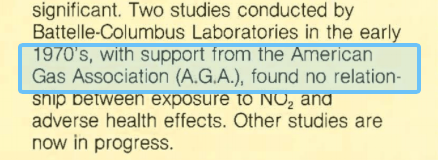
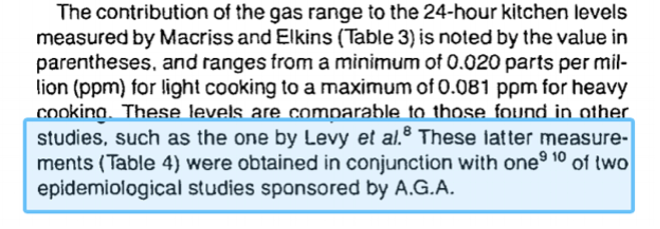
This made me wonder whether Hill & Knowlton, the architects of that strategy, might have been involved. So I started looking in old gas-industry magazines for potential leads. One of these, from 1972, included a listing for a “Public Relations Workshop Report” and there it was in black-and-white: a Hill & Knowlton executive center stage at AGA’s 1972 PR Workshop, recommending key facets of the firm’s tobacco playbook to the gas industry. And not just any Hill & Knowlton executive but Richard Darrow, its then president, who had previously been responsible for the tobacco account! That felt like history leaping off the page.
DEMELLE
That’s incredible. So walk us through the timeline — when did independent scientists begin to become concerned about the health impacts of gas stoves? Was the gas industry already thinking about the issue?
JOHN
Concerns about the health impacts of gas stoves go back to the early 1900s but things began to crystallize in the 1960s with advances in laboratory-based understanding of NO2 as a respiratory irritant, alongside anecdotal evidence of patients suffering from gas-stove-related conditions. In 1970, EPA researchers found a link between outdoor NO2 and respiratory problems in schoolchildren, which led to the launch of the agency’s first study into the health effects of indoor gas stove emissions. These EPA researchers found peak NO2 levels from gas stoves of 1,000 parts per billion (ppb) — around 20 times higher than the legal outdoor standard. They also found that homes with gas stoves reported more respiratory problems than those with electric stoves. A few months later, the New York Times reported on the study, bringing national attention to the issue, and an op-ed in the Yale Law Journal described indoor air pollution, as a “menace” that required “comprehensive federal legislation.”

Documents show that by 1970 the gas industry — which had been trying to position gas as a “clean burning” alternative to coal-fired electricity generation — was aware it had a potential problem with NO2 emissions. In response to these EPA studies, it began to examine gas stove emissions.
DEMELLE
So the industry knew public concern about the health impacts of gas stoves could be an existential threat. And the documents you found show that it turned to the PR firm Hill & Knowlton, which had worked with Big Tobacco and is credited with creating the “tobacco strategy.” What is that strategy and why is it relevant in this case?
JOHN
By 1972, when the gas industry turned to Hill & Knowlton for help, the PR firm was already expert in making this kind of threat go away. Thanks to successful litigation against cigarette companies, we actually know a lot about the tobacco strategy — the tactics that Hill & Knowlton used to sow doubt over the health harms of smoking and protect cigarette sales. The documents obtained through litigation now form part of the invaluable Industry Documents Library at the University of California San Francisco, and show exactly how Big Tobacco spent millions of dollars on research to defend and protect the industry. These documents, along with other findings, also demonstrate how multiple industries have employed this strategy to deny the health and environmental hazards of asbestos, lead, plastics, toxic chemicals, CFCs, and carbon dioxide emissions from burning fossil fuels. Our new report shows that gas stove emissions should also be added to that list.
DEMELLE
You found that not only did the gas industry work with Hill & Knowlton, it specifically turned to the same executives who had advised Big Tobacco. What did Hill & Knowlton tell the gas industry to do?
JOHN
So in 1972, Richard Darrow, one of the architects of Hill & Knowlton’s tobacco strategy, told the gas industry that it should mount “massive consistent, long-range public relations programs” to cope with its pollution problems. Once I knew that Darrow had spoken at the PR Workshop, I tracked down a complete version of his speech which showed him advising the industry that “continuing research” should be a part of its daily activities and that it should use this research to “quiet” consumer fears over gas appliances in the home and get ahead of bad news.
If it did this effectively, Darrow promised that the industry would be able to make its “voice heard” and play a role in “shaping the decisions” that would affect the nation’s future and, by extension, the industry’s ability to profit.

The following year, Carl Thompson, another central figure in Hill & Knowlton’s work for tobacco, repeated a similar message to the gas industry: If it didn’t help inform the public, people would get all their information from the industry’s critics.
What’s striking is the similarity between this advice Darrow and Thompson gave to the gas industry in the 1970s and one of Hill & Knowlton’s earliest recommendations to its tobacco clients in the 1950s — that they should seek to reassure the public through the communication of “weighty scientific views” that held there was no proof that cigarette smoking caused lung cancer. What we see very clearly in the documents is that when faced with public concerns about gas stove emissions in the early 1970s, the gas industry would fund “weighty scientific views” of its own.
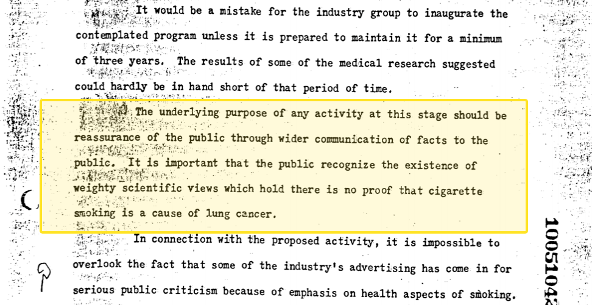
DEMELLE
How did the gas industry go about getting those “weighty scientific views”?
JOHN
Well, first of all they didn’t waste any time. Barely two months after Darrow advised the gas industry to adopt a policy of “continuing research,” the AGA started funding its own epidemiological studies at Battelle, a private lab that had previously conducted research for Hill & Knowlton’s clients, including the American Petroleum Institute (API) and Big Tobacco. Interestingly, agreements between Battelle and various tobacco firms show that Battelle had a track record of agreeing to publish information that was “consistent with the Sponsor’s interests and wishes.”
Two researchers from the Ohio State University College of Medicine also joined the Battelle scientists, giving the AGA-funded research an appearance of greater credibility. This is important because one of the key services Hill & Knowlton provided for its tobacco clients was recruiting carefully selected scientists who would provide a veneer of credibility while conducting research likely to generate a controversy over the link between cigarettes and cancer. And records show that at least three members of the research team from Battelle and Ohio State may have been selected due to their previous interests and approach.
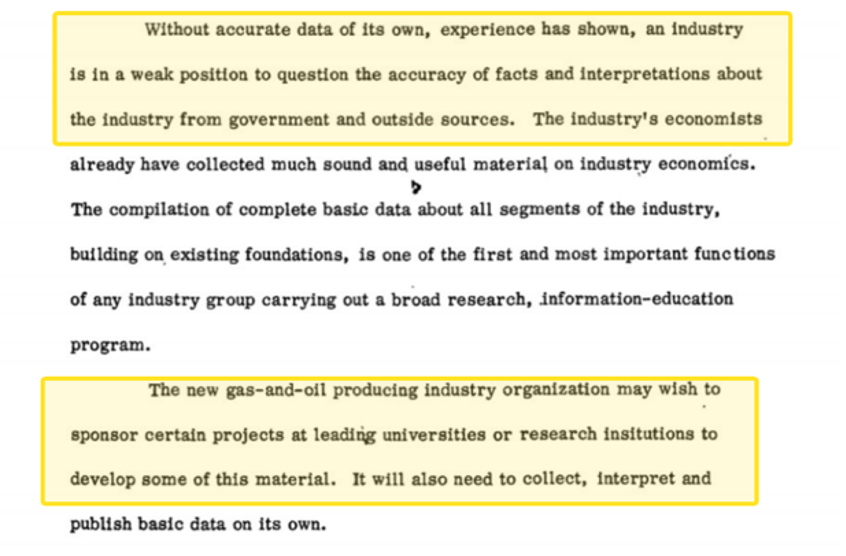
Additionally, documents we found also show that this wasn’t the first time Hill & Knowlton had recommended such a strategy to the gas industry. As early as the mid 1950s, a Hill & Knowlton team, including Richard Darrow, had advised the gas industry to sponsor research at “leading universities or research institutions” which it would be able to use to question the accuracy of facts from “government and outside sources.”
DEMELLE
It’s chilling to see how systematic and long-range these influence campaigns are. What were some key industry-funded studies, and what were their conclusions?
JOHN
Based on what we know, the gas industry funded two major sets of epidemiological studies — first in the 1970s, and again in the late 1980s and early 1990s. In contrast to a growing body of non-industry-funded research, which increasingly identified an association between gas stove emissions and respiratory problems, the 1970s studies conducted by the Battelle and Ohio State researchers (Mitchell et al., 1974; and Keller et al., 1974) found no evidence for gas-stove-related respiratory problems. Two similar follow up studies (Keller et al., 1979 I & II) were published in the journal Environmental Research without any disclosure of AGA-funding. To this day, AGA-funding is not disclosed in the journal’s online versions. Then, in the late 1980s, the gas industry, this time under the direction of the Gas Research Institute (GRI), which had taken over AGA’s research program, funded another major study in partnership with the Health Effects Institute — a research organization co-funded by the EPA and 28 automobile industry companies. This study (Samet et al., 1993) to which GRI contributed upwards of $1 million, or approximately a third of the funding, again found no association between gas stoves and respiratory illness.
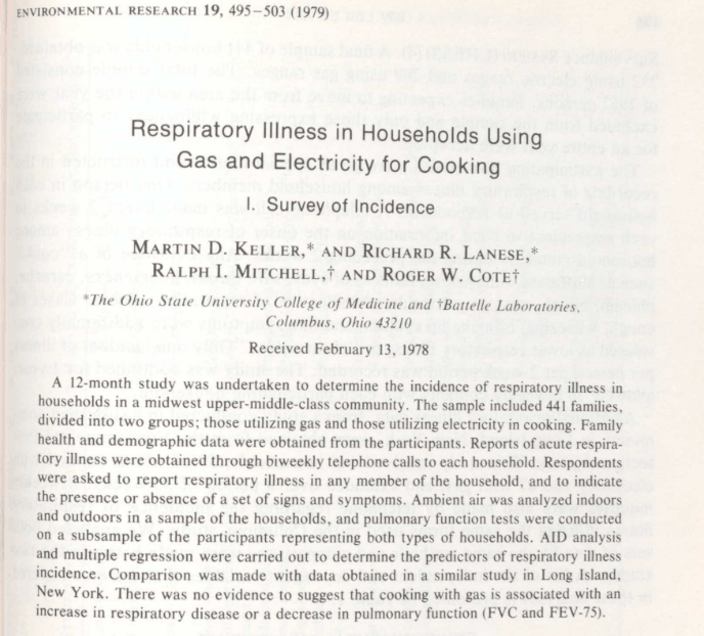
DEMELLE
What impact did these studies have on policy and regulation? And was the industry taking other steps to impact policy?
JOHN
Yes the industry was absolutely doing other things. As well as funding epidemiological studies, the gas industry was also funding third-party consultants and statisticians to attack research — another tactic that had proven highly effective for Big Tobacco under the direction of Hill & Knowlton. Again, industry funding of these third parties was not always disclosed.
Gas industry representatives then amplified these paid-for findings to promote doubt and maximize uncertainty. On some occasions the industry went one step further, using this apparent uncertainty as a springboard to make much bolder claims. For example, in 1982, a GRI spokesman declared outright that “emissions from unvented gas appliances do not cause any undesirable effects.” During this period, the gas industry was also pursuing marketing and advertising campaigns, product placement deals in movies and TV shows, and celebrity tie-ins — another tobacco favorite — with famous cooks such as Julia Child. I know, is nothing sacred?!

Coming back to your question about the impact these studies had on policy and regulation, we can see quite clearly in the historical record that they disrupted what might otherwise have been an emerging consensus regarding the health effects of gas stove emissions. And, from the late 1970s up to as late as the 1990s, industry-funded studies contributed to decisions by EPA regulators that the evidence was “not conclusive” and more research was needed.
One document from 1978 shows the actual moment an industry representative insists that the EPA include the AGA-funded studies in its assessment of the health harms — which, of course, it did. A later EPA document from 1982 contains a table that provides striking visual evidence of this influence: The agency considered nine gas stove studies, four of which found an association between gas stoves and respiratory problems, while five found no evidence of an association. Four of these five papers that found no association were the undisclosed AGA studies conducted by the Battelle/Ohio State researchers. So you can see just how powerful an influence these AGA-funded studies had in shifting the balance of evidence in the industry’s favor. This influence continued over subsequent decades. The outdoor NO2 standard was only revised in 2010 and regulations for NO2 still stop at the doorway of U.S. homes.
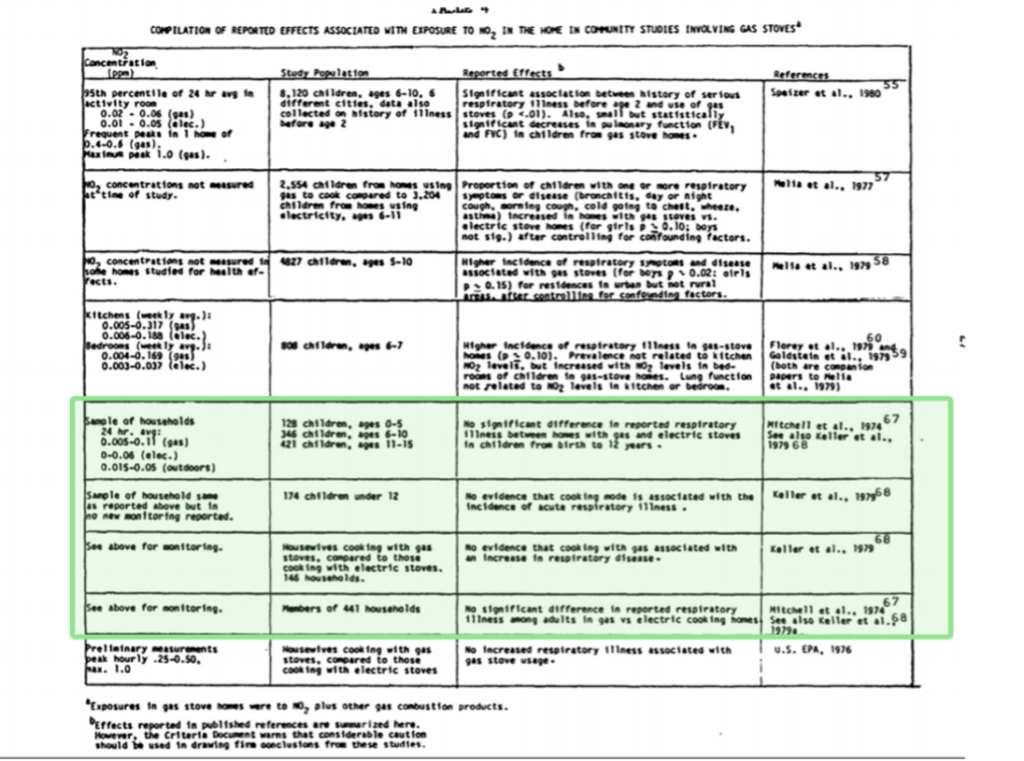
DEMELLE
How is the gas industry still using these tobacco tactics?
JOHN
So the gas industry continues to use tobacco tactics in a variety of ways. It’s still sponsoring its own research focusing on gas stove emissions, as well as new literature reviews that attack independent health effects research. For example, late last year a major study attributed 1 in 8 cases of childhood asthma in the U.S. to the presence of a gas stove in the home. In response, the AGA funded a literature review conducted by Gradient, a private consulting firm. And, just like the reviews commissioned by the gas industry in the 1980s, Gradient’s review concluded that there was insufficient evidence to prove a causal relationship between gas cooking or indoor NO2 and asthma. Since then, the gas industry has amplified the results of its studies, making spurious complaints against academic research to push back against the evidence and hiring influencers to portray gas cooking in a positive light. These are all classic tobacco tactics.
DEMELLE
Despite the industry’s continued efforts to fight regulation and downplay the health harms of gas stoves, are people beginning to be more aware of or concerned about the risks of gas stoves?
JOHN
I think people are becoming more aware. Definitely. For one thing, people do seem to be waking up to the fact that cooking on a gas stove means that you are combusting a fossil fuel in your home and that this is causing pollutants to build up indoors — not only NO2 but also benzene, a known carcinogen, and the powerful greenhouse gas methane.
The science has also grown. In 2010 when the EPA introduced a tighter standard for outdoor NO2, it noted that a substantial amount of new research had contributed to its decision, especially studies that show children and people with asthma are more likely to develop respiratory problems related to NO2 exposure. Since then other studies have confirmed this association, as well as a link between indoor NO2 exposure and morbidity in people with chronic obstructive pulmonary disorder. On top of this, the health impacts of gas stove emissions may disproportionately affect lower-income households and people of color, many of whom already live in neighborhoods with polluted outdoor air. Pollutant concentrations tend to be higher in smaller living spaces, in kitchens without a working ventilation hood, and in homes where windows are kept shut against outdoor pollution. A 2020 report by the Asthma and Allergy Foundation found that the burden of asthma falls more heavily on Black, Hispanic, and Native American populations, with mortality and emergency room visits higher for these groups. I think it’s also important to note that researchers who have worked in this area for decades, who may have previously concluded that more research was needed, are now saying that steps should be taken to protect those who are susceptible and that we should not wait any longer to begin preventive action against the negative effects of gas stove emissions.
DEMELLE
What’s the one big takeaway you hope that readers glean from these documents and your research?
JOHN
To me, the importance of this work lies in revealing how the fossil fuel industry has maintained — and continues to maintain — the energy status quo, despite the health and climate risks.
Subscribe to our newsletter
Stay up to date with DeSmog news and alerts


